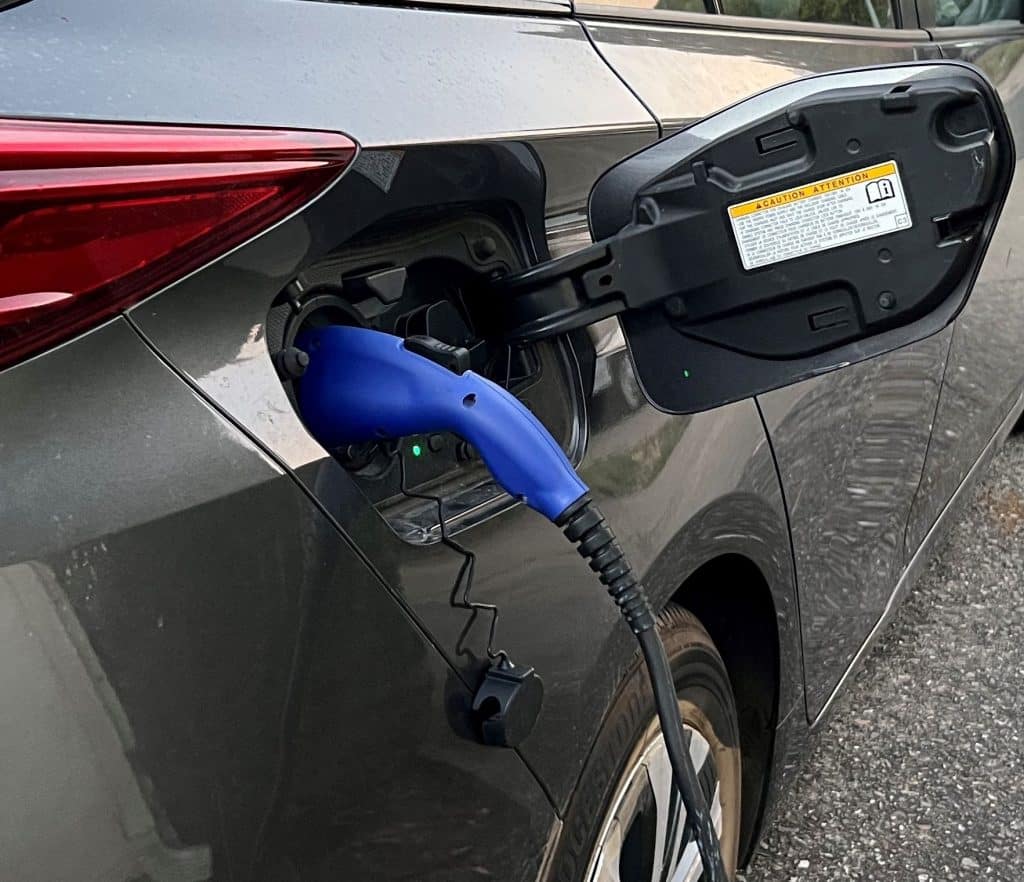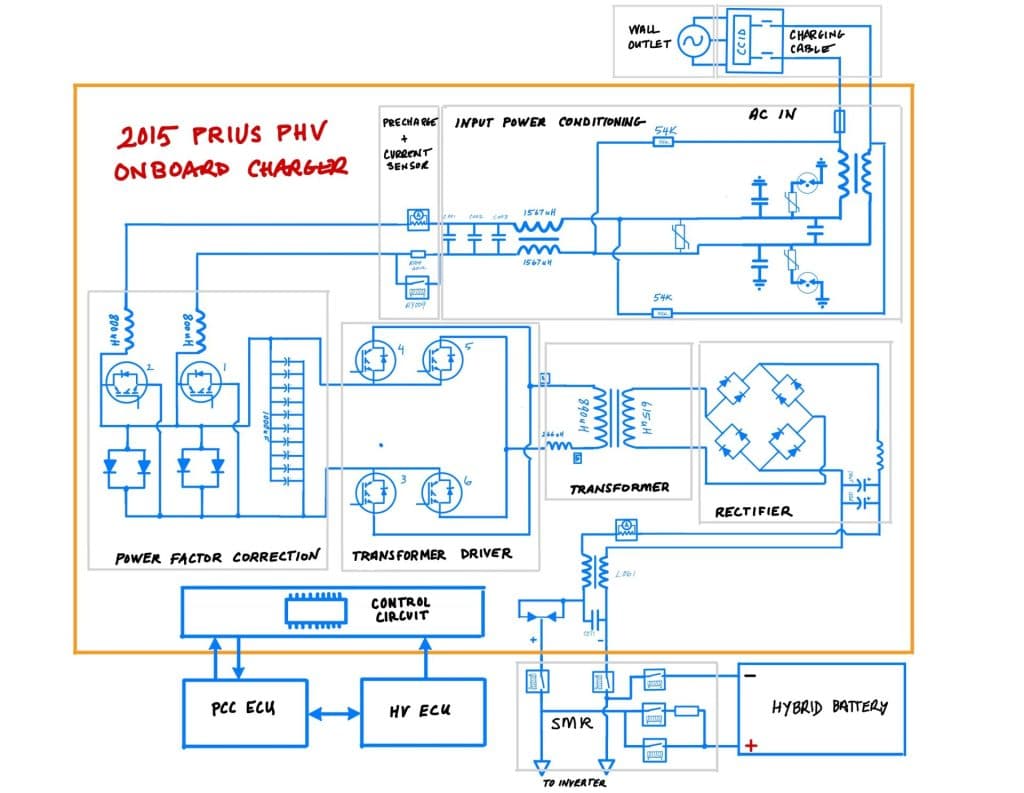P0D67-844 indicates a fault with your Prius’ onboard charger. In this article I’ll cover what P0D67 means and how to diagnose and repair the issue.
WHAT IS AN ONBOARD CHARGER?
Let’s start with the basics. What is the on-board charger? A common misconception is that the cable that connects the wall outlet to the charging port is a charger. It’s not.
The cable is called EVSE (electric vehicle supply equipment) or simply charging cable. Unlike your cell phone or laptop charger, there is no charging circuitry in the mid-cable box.
The onboard charger is located inside of your Prius under the high voltage battery. Its job is to convert AC voltage from your wall outlet to higher voltage DC to charge your hybrid battery pack.
IF A P0AD67 SETS, IS IT REALLY NECESSARY TO REPAIR IT?
I’ll break this into two questions: “Is it mandatory to repair the onboard charger if there’s a fault?” and “Is it worth it to repair the onboard charger if there’s a fault?”

Is it mandatory to fix a P0D67? Maybe. If the car fails a smog inspection due to the code, then yes. If not, then not really. Your Prius will still work as a non-plug-in Prius without a working onboard charger. In fact, it will still get a little bit better mileage than a non-plug-in Prius because of the larger battery and the ability to capture more energy from regenerative braking.
Now, should you fix it? Probably. If you plug your Prius in, you’ll increase your mileage substantially. Repairing the charger will pay for itself in fuel savings, but it will take a while. This will vary a bit depending on how you use the car. A person who drives 20 miles a day has more to gain (at least as percentage of fuel cost and total MPG) than a person who drives 100 miles a day.
What causes P0D67 to set?
The onboard charger performs self-testing, just like most modern automotive electronic systems. However, it doesn’t report on the area of failure. I don’t know how many tests are built into its self-diagnostic routine, but for the sake of discussion let’s just say there are 10 tests. A P0D67-844 will set if a single test fails, or all 10 tests fail. There’s only one trouble code regardless of the fault.
There are no specific trouble codes for different failures because it’s expensive to create software and interface for diagnostic assistance, and Toyota doesn’t consider the onboard charger to be serviceable. If any of the internal tests fail, the solution is to replace the onboard charger with a new part as far as Toyota is concerned. Since this is their philosophy, only one code is necessary: P0D67 “On-Board Charger Malfunction”.
If you want to find out what’s wrong with the onboard charger, you’ll need figure out how it works and then do the testing on your own, just like the old days. Although in the old days most electronics were provided with diagrams. Now everything is a sUpeR SeCret.

HOW DOES THE ONBOARD CHARGER COMMUNICATE FAULTS WITH THE ONBOARD CHARGING ECU?
Since adding networking capabilities costs money, and Toyota only wants the onboard charger to communicate 3 “states” with the ECU, the communication is very simple. Communication is just a simple change in duty cycle on a single wire network.
- When the charger is OK but not doing anything, it outputs a 24% duty-cycle square wave
- When the charger is working, it outputs a 51% duty-cycle square wave
- When the charger has failed any of its self-tests, it outputs a 78% duty-cycle square wave



How do you diagnose a P0D67?
This is pretty simple. First you make sure none of the following codes are also stored.
- P0A1D
- P0ADC
- P0AE0
- P2511
- P3004
- U019B
Assuming P0D67 is your only code, and none of those codes are present, you’ll need to check the duty-cycle on pin 29 of connector Z12 of the onboard charging ECU and compare it to the PID “Charger State Pulse Duty Ratio”. If the PID and the actual measurement are about the same, the onboard charger is bad. Pretty simple.
Is there a less expensive way to repair an onboard charger?
The last charger we replaced was about $2700 out the door. It’s not an inexpensive part.
However, the onboard charger is actually a very serviceable part. It does require some skills that most automotive mechanics don’t have, but it’s certainly a lot easier than board level repair on laptops and cell phones. Parts are comparatively large and easy to solder. Toyota hasn’t obfuscated chip markings and most component are available from the normal sources.
I’ve spent a lot of time reverse engineering the 2012-2016 Prius Plug-in Charger, and I think I have it pretty well figured out. I used some of the information I learned for an article in ToyotaTech magazine you may find interesting.
I have successfully repaired one at this point and I suspect that this is a service we’ll be able to offer regularly in the future, just like our 2004-2009 Prius combination meter repair. However, until I’ve repaired multiple failures, we’ll offer the onboard charger repair on a case-by-case basis.

P0D67 diagnosis and onboard charger repair
If you have a P0D67 and live near Berkeley California we’d be happy to take a look at your Prius. Your particular charger may or may not be repairable, but we’ll be able to fix the car for you regardless, and at least there’s a possibility of a less expensive repair, which is something you’re not going to find at most auto repair shops.
Other people who repair electronics
If you don’t live near us and want to try mail order, check with AutoBeYours. They may offer mail in repair services or a known good used part.
2011-2012 Nissan LEAF onboard charger repair
There’s a guy in New Zealand who came up with a way to repair the 2011 – 2012 Nissan LEAF onboard charger and then created an instructional video about how to diagnose and repair the LEAF onboard charger, which is very generous. It took me a lot of time to figure out how the Prius onboard charger failed. When you put time and effort into a project you hope to be able to make a profit on it at some point, or at least recoup some of the cost.
Anyway, this guy is super cool for providing it as a public service in exchange for recognition only. I’m sure he has helped hundreds of LEAF owners worldwide and deserves recognition, so here’s a link to the guy in New Zealand who repairs 2011-2012 Nissan LEAF onboard chargers.
